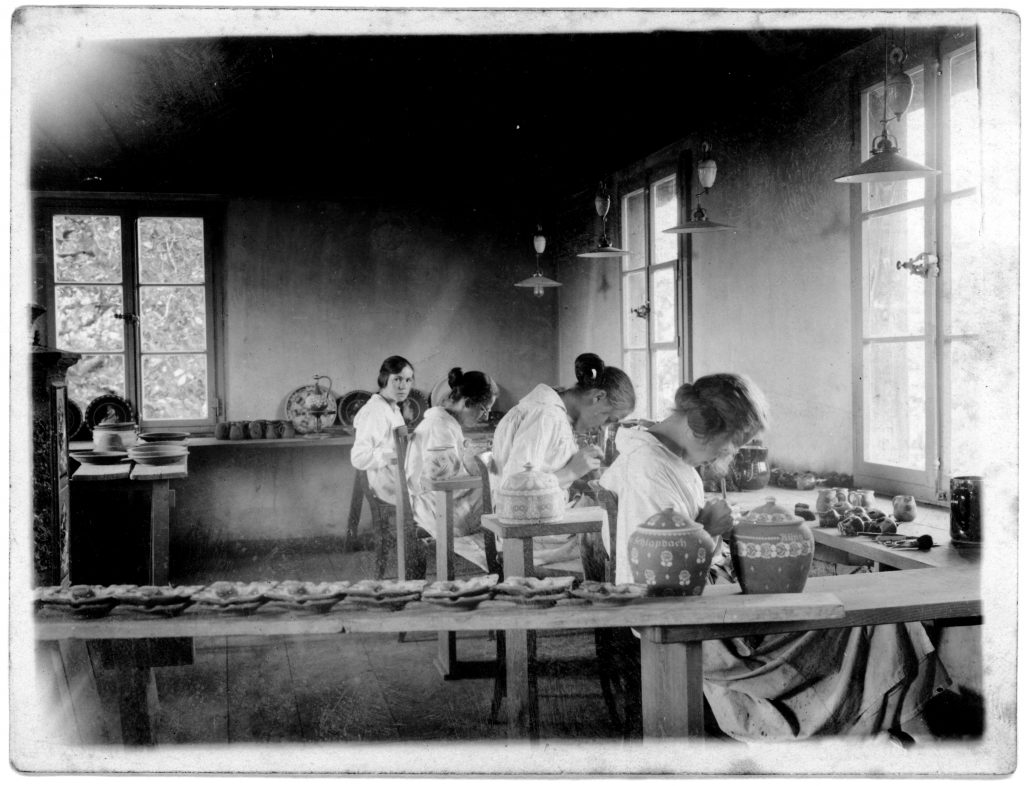
The former Wanzenried Manufactory buildings during the Loder & Schweizer period (1919-1925).
Pottery made by Loder & Schweizer in CERAMICA CH
Photo album of the products (now in the State Archive of Lucerne, PA 1421/PLA 202, Kunstkeramik Luzern company archive)
Andreas Heege, Andreas Kistler, Margret Loder, 2023
We know that on 11th December 1918 Adolf Schweizer (1893–1967) and Emil Loder (1890–1971) jointly purchased the manufactory from the widow Wanzenried for the sum of 18,000 Swiss francs (15,000 francs of which came in the form of a promissory note) and took over the company including its assets and liabilities from 2nd April 1919 (land register GB Thun, Beleg II, 775 17/3/1919). The founding of their partnership on 1st March 1919 was announced in the Swiss Official Gazette of Commerce (SOGC 37, No. 59, 8th March 1919).

Announcement of the partnership published in the Swiss Official Gazette of Commerce in 1919.
Adolf Schweizer had served his apprenticeship at the Wanzenried Manufactory and at the time they purchased the company was the managing director of DESA in Steffisburg. Emil Loder had probably been the managing director of the manufactory since the end of 1915. We can only speculate that the two had met socially in Steffisburg or had perhaps known each other from before, given that, in 1917, Adolf Schweizer had married Elise Eyer (1892–1970), who worked at the manufactory as a pottery paintress and was the daughter of potter Gottfried Eyer (1856–1892) and his wife Elise Gfeller.
The Wanzenried Manufactory became:

(Note: The founding date of 1876 is incorrect! The Wanzenried Manufactory was founded in September 1878).
A photo album in Emil Loder’s estate (now in the State Archive of Lucerne, PA 1421/PLA 202, Kunstkeramik Luzern company archive) bears witness to products from their joint venture. Loder & Schweizer continued to produce some of the successful patterns and ranges of ceramic wares that had been introduced by the Wanzenried Manufactory, including the Alt-Thun/Chrutmuster pattern and an earthenware production line with slip-trailing and incised decoration.





Photo Antik und Rar, Angelo Steccanella.
At the same time, numerous new shapes and decorations were developed, no doubt mainly by Emil Loder, who numbered each design. Stylistically, his decorative motifs would be considered to be Late Art Nouveau or Art Deco.



Painting shop at Loder & Schweizer, c. 1919-1925.


Ceramic designs by Paul Wyss were used regularly.

Emil Loder also turned his hand to sculpting; various animal figures were produced by the manufactory and were offered for sale in MUBA catalogues under the category “small sculptures”.


Ceramic objects made by Loder & Schweizer from the School of Design’s collection in Bern.






The manufactory mark was a ligature logo “LS” (Loder & Schweizer), which was often combined with the placename Steffisburg and the shape or decoration number.


Vessels decorated with the “Alt-Thun/Chrutmuster” pattern, however, still bore the two stars from the Wanzenried Manufactory and the placename “Thoune”.

Sales were partially generated via the Mustermesse fair in Basel, which had been founded in 1917 and at which Loder & Schweizer are known to have exhibited from 1920 to 1924 (Official catalogue of the Mustermesse Basel, 1920-1924). Shown here is the invitation by Loder & Schweizer to its customers to attend MUBA 1924.

In 1922, Loder & Schweizer participated in the “Première Exposition nationale d’art appliqué [First National Exhibition of Applied Arts], Group 7, pottery” in Lausanne (6th May-25th June 1922), organised by Nora Gross. On that occasion, the former Museum of Arts and Crafts in Geneva purchased a sugar bowl or box which is now in the collection of the Musée Ariana in Geneva (MAG C0798).

In 1924, the Loder & Schweizer Art Pottery Workshop participated in the KABA (KAntonal-Bernische Ausstellung – Canton Bern Exhibition) in Burgdorf (State Archive of Bern – StAB BB 1.9.7). The BUND newspaper reported: “The exhibits of two art pottery workshops from Bern, Loder and Schweizer in Steffisburg and Adolf Gerber in Langnau, have received much attention. The Steffisburg company represents a welcome progression in the modern genre. We find animal figures as elegant and full of life as the best “Copenhagen” products, and exquisitely shaped vases with delightful glazes.” (Der Bund, Volume 75, No. 334, 8th August 1924).

From the correspondence between Emil Loder and his future wife Frieda Schenk we know that, in early 1925, Emil Loder and Adolf Schweizer decided to dissolve their partnership due to a dispute. What led to the dispute is not known, but it did not stop the former colleagues in subsequent years from taking on major contracts together, for example for the 1939 Federal Shooting Festival in Lucerne. Adolf Schweizer acquired the company in 1925 and Emil Loder moved to Lucerne, where he took over the factory then known as “Keramik Luzern, Genossenschaft” and set up the Kunstkeramik A.G. Luzern or Luzerner Keramik (Heege/Loder-Rettenmund/Kistler 2023; Heege/Loder-Rettenmund/Kistler 2024).
Loder & Schweizer on Antik und Rar
Loder & Schweizer in the collection of the Swiss National Museum
Translation Sandy Haemmerle
Referenzes:
Heege/Loder-Rettenmund/Kistler 2023
Andreas Heege/Margret Loder-Rettenmund/Andreas Kistler, Luzerner Keramik 1925–1996, Teil 1: Loder-Schenk, Luzern, Kunstkeramik (1925–1933) und Kunstkeramik A.G. Luzern (1933–1948), in: Keramik-Freunde der Schweiz Revue 137, 2023, 1-101.
Heege/Loder-Rettenmund/Kistler 2024
Andreas Heege/Margret Loder-Rettenmund/Andreas Kistler, Luzerner Keramik 1925–1996, Teil 2: Kunstkeramik A.G. Luzern in Ebikon (1948-1996), in: Keramik-Freunde der Schweiz Revue 138, 2024, 7-101.

